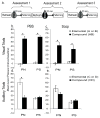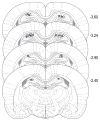Learning history and cholinergic modulation in the dorsal hippocampus are necessary for rats to infer the status of a hidden event
- PMID: 26703089
- PMCID: PMC4866895
- DOI: 10.1002/hipo.22564
Learning history and cholinergic modulation in the dorsal hippocampus are necessary for rats to infer the status of a hidden event
Abstract
Identifying statistical patterns between environmental stimuli enables organisms to respond adaptively when cues are later observed. However, stimuli are often obscured from detection, necessitating behavior under conditions of ambiguity. Considerable evidence indicates decisions under ambiguity rely on inference processes that draw on past experiences to generate predictions under novel conditions. Despite the high demand for this process and the observation that it deteriorates disproportionately with age, the underlying mechanisms remain unknown. We developed a rodent model of decision-making during ambiguity to examine features of experience that contribute to inference. Rats learned either a simple (positive patterning) or complex (negative patterning) instrumental discrimination between the illumination of one or two lights. During test, only one light was lit while the other relevant light was blocked from physical detection (covered by an opaque shield, rendering its status ambiguous). We found experience with the complex negative patterning discrimination was necessary for rats to behave sensitively to the ambiguous test situation. These rats behaved as if they inferred the presence of the hidden light, responding differently than when the light was explicitly absent (uncovered and unlit). Differential expression profiles of the immediate early gene cFos indicated hippocampal involvement in the inference process while localized microinfusions of the muscarinic antagonist, scopolamine, into the dorsal hippocampus caused rats to behave as if only one light was present. That is, blocking cholinergic modulation prevented the rat from inferring the presence of the hidden light. Collectively, these results suggest cholinergic modulation mediates recruitment of hippocampal processes related to past experiences and transfer of these processes to make decisions during ambiguous situations. Our results correspond with correlations observed between human brain function and inference abilities, suggesting our experiments may inform interventions to alleviate or prevent cognitive dysfunction. © 2015 Wiley Periodicals, Inc.
Keywords: acetylcholine; inference; negative patterning; positive patterning; representation; stimulus ambiguity.
© 2015 Wiley Periodicals, Inc.
Figures





References
-
- Abramoff MD, Magalheas PJ, Ram SJ. Image processing with ImageJ. Biophotonics International. 2004;11:36–42.
-
- Alvarado MC, Rudy JW. A comparison of kainic acid plus colchicines and ibotenic acid-induced hippocampal formation damage in four configural tasks in rats. Behav Neurosci. 1995;109:1052–1062. - PubMed
-
- Blaisdell AP, Leising KJ, Stahlman WD, Waldmann MR. Rats distinguish between absence and lack of information. Int J Comp Psychol. 2009;22:1–18.
-
- Ghirlanda S, Enquist M. A century of generalization. Anim Behav. 2003;66:15–36.
MeSH terms
Substances
Grants and funding
LinkOut - more resources
Full Text Sources
Other Literature Sources
Miscellaneous

